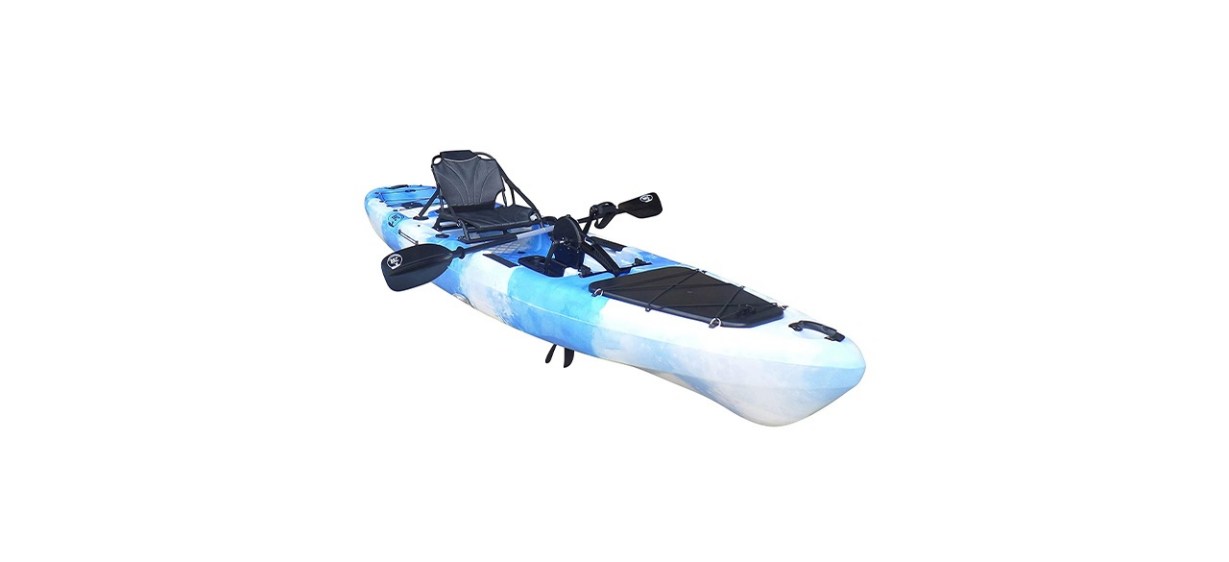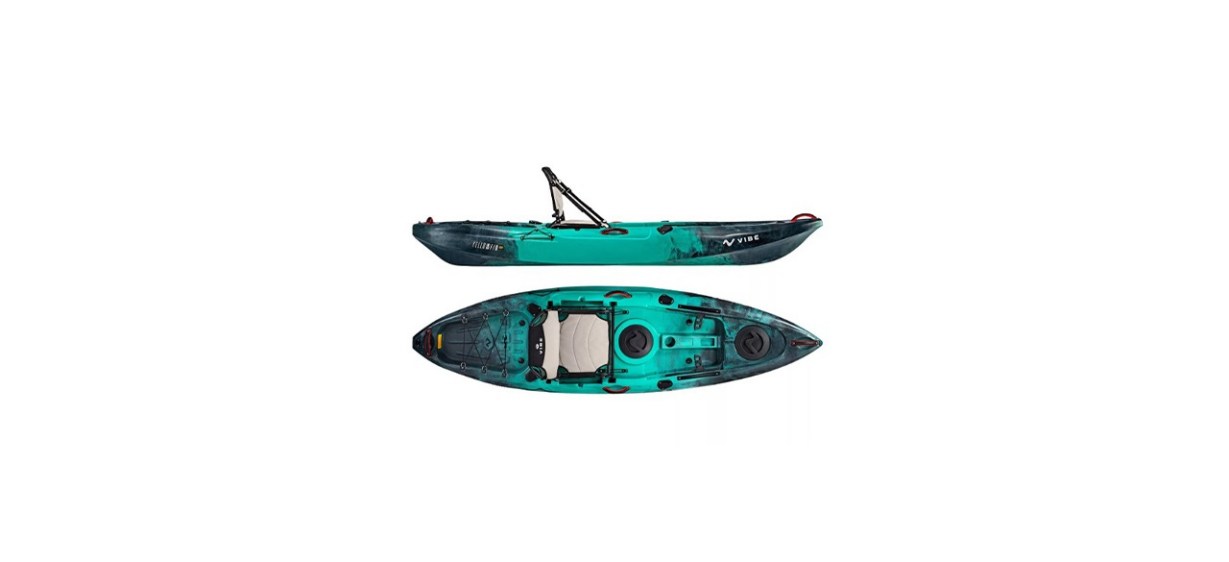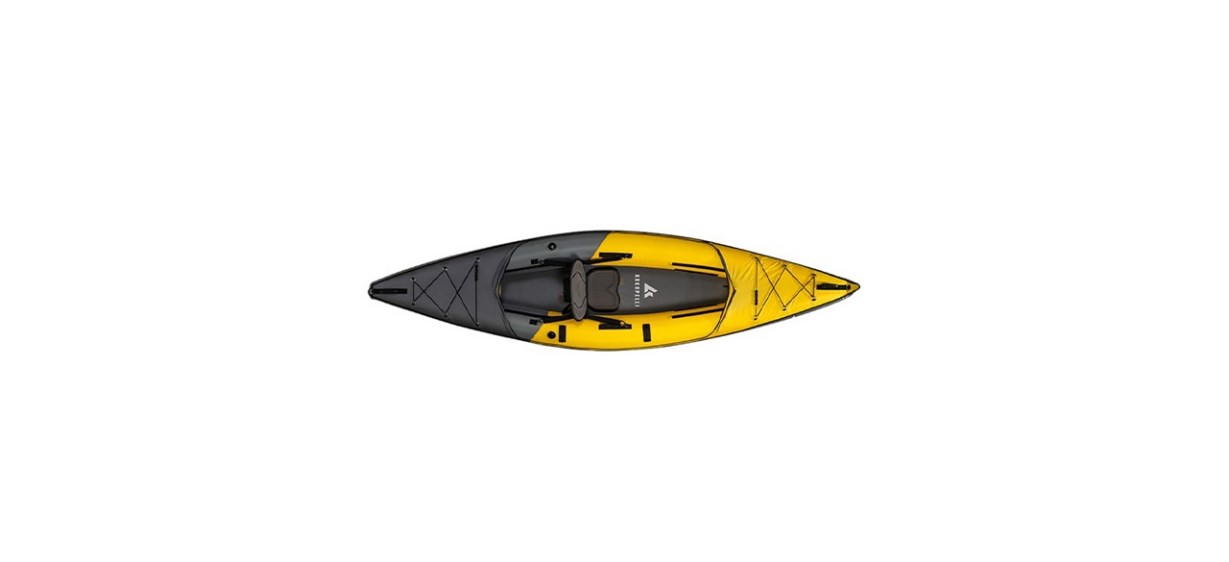Which kayak is best?
Kayaks are a great way to spend the day having fun on the water while also getting a bit of exercise. Long popular as a whitewater sport, it is becoming increasingly common in saltwater applications for anglers and casual beachgoers alike.
While there are many basic models that simply provide you with a platform to sit on and paddle, some kayaks are packed with features that make for more efficient propulsion, comfort for all-day adventures and more convenient fishing. The BKC PK13 Pedal Drive Fishing Kayak is one such model. It is pedal-driven, so you can operate it by foot when you want your hands free for performing other tasks, has an ergonomic seat with a supportive backrest and boasts three rod holders.
The two main types of kayaks
Kayaks come in two basic styles: sit-in and sit-on-top, and your first decision should be which type to buy.
Sit-in kayaks
Sit-in kayaks are seen more often in whitewater applications, though they are sometimes also used for lake and ocean paddling. They have an open cockpit that you place your legs inside of, and some feature a skirt that you can attach to block wind and water spray. This makes them a popular choice for use on cold days. Another benefit of sit-in kayaks is that you can brace your legs against the inside walls of the hull, which allows you to put more power into your paddling stroke without compromising your stability.
It should be noted that sit-in kayaks can be intimidating for some. If you flip them, you need to be able to get yourself out of the kayak while underwater or know how to right yourself, which takes some practice. They also tend to have less storage space than sit-on-top kayaks.
Sit-on-top kayaks
Sit-on-top kayaks are often the best kayaks for beginners and are generally only used for lake, ocean and calm river paddling. These feature molded-in or removable seats, which you can easily climb out of for a quick dip and re-enter from the water without having to head back to shore first. Many also find them to be more comfortable, as they provide more room to stretch out, as well as more space for coolers and other gear.
The biggest downside to sit-on-top kayaks is that it is almost impossible to keep yourself or your gear dry, which is why they usually have some kind of dry storage compartment. They are popular for warm-weather but less so for cold water applications.
Features to look for in a quality kayak
Back support
Whether or not you have back pain, choosing a kayak with back support is a smart idea if you plan on paddling for more than an hour or so. They allow some of the muscles in your lower back to relax when needed so you can stay comfortable while continuing to paddle efficiently. Some models with back support may also include a cushioned seat.
Adjustable footrests
Footrests provide additional comfort, control, stability and power when paddling. When they are adjustable, it makes the kayak more accommodating to a wide range of users and helps you achieve the most ergonomic position for your body.
Dry storage compartment
Whether whitewater kayaking or paddling on a calm day on a lake, there is a good chance just about everything on your kayak will get wet at some point. If you want to be able to bring along a camera, a phone, a map or anything else that can get damaged from exposure to water, you’ll need a kayak with dry storage compartments.
Storage well
The majority of dry storage compartments on kayaks are only designed to accommodate small items. Larger gear, such as a cooler, needs to be placed in a storage well. Ideally, these should have bungee straps to hold the contents in place.
Cupholder
While not a necessity, having a cupholder on a kayak can be very convenient for keeping a bottle of water or other beverage close at hand. They can also often be used as mounting places for gear.
Rod holders
If you plan on fishing from your kayak, rod holders are invaluable. Not only do they free up your hands for looking at a fish finder, paddling or having a snack while you wait for a fish to bite, but they also allow you to put out more than one line at a time.
Carrying handles
The majority of people don’t leave their kayak in the water at all times. This means you should expect to be carrying it from your home to the water and potentially your car as well if you need to transport it. In these instances, carrying handles will make the task easier.
Paddle parks
Paddle parks provide you with a dedicated spot to put your paddles when you don’t want to hold onto them for a little while. These should have bungee cords or some other fastening system to ensure the paddles don’t slip off.
Pedal drive
Kayaks with pedal drives offer an alternative way to propel your kayak. Instead of having to paddle the whole time, which can get tiresome for those without a lot of upper body strength, you can also use your feet to spin a propeller.
How much can you expect to spend on a kayak?
The most affordable kayaks start around $200, though these will often be low-quality inflatables that aren’t very durable or basic hard kayaks with limited features that are suitable for short periods of casual paddling. If you plan on kayaking regularly, consider spending at least $600-$1,700 for a model that tracks better, is more stable in the water and has a range of useful features.
Kayak FAQ
Do I need to wear a life jacket when kayaking?
A. Yes. You should always wear a life jacket when kayaking, no matter how calm the water looks. It is also prudent to bring along a whistle so you can signal for help if needed.
Is kayaking difficult?
A. Certain types of kayaking are more difficult than others. If you plan on kayaking in a lake or in the ocean on a reasonably calm day, you’ll find kayaking doesn’t take too much skill and can be a fun activity for those with no previous experience. Conversely, whitewater kayaking is much more difficult and requires practice and, often, time spent with an instructor to learn the basics.
What is the best kayak to buy?
Top kayak
BKC PK13 Pedal Drive Fishing Kayak
What you need to know: This foot-operated kayak makes it easy to travel far distances and is packed with features that make it ideal for angles.
What you’ll love: It leaves your hands free for holding the rod and has a large dry storage compartment, and the high and supportive seat allows you to spot disturbances in the water that may signal schools of fish.
What you should consider: It is large and heavy, which makes it cumbersome to transport.
Where to buy: Sold by Amazon
Top kayak for the money
What you need to know: Offering just the right balance of size, features and performance, the Yellowfin 100 is suitable for casual paddlers and anglers alike.
What you’ll love: It boasts two dry storage compartments, has an adjustable seat and footrests to keep you comfortable during long days on the water and feels very stable during use.
What you should consider: It has trouble tracking straight in strong currents.
Where to buy: Sold by Dick’s Sporting Goods
Worth checking out
Kokopelli Moki I Inflatable Kayak
What you need to know: A top choice for those with limited storage space or small vehicles, this rugged inflatable kayak weighs just 37 pounds and packs down to only 29 x 14 x 13 inches when not in use.
What you’ll love: It is made with three separate air chambers to minimize the risk of sinking if it gets punctured somehow, and it features D-rings with bungee straps on the front and back for securing gear.
What you should consider: It narrows quickly towards the front and back, which can make it feel constrictive to some paddlers.
Where to buy: Sold by Backcountry
Want to shop the best products at the best prices? Check out Daily Deals from BestReviews.
Sign up here to receive the BestReviews weekly newsletter for useful advice on new products and noteworthy deals.
Brett Dvoretz writes for BestReviews. BestReviews has helped millions of consumers simplify their purchasing decisions, saving them time and money.
Copyright 2022 BestReviews, a Nexstar company. All rights reserved.




